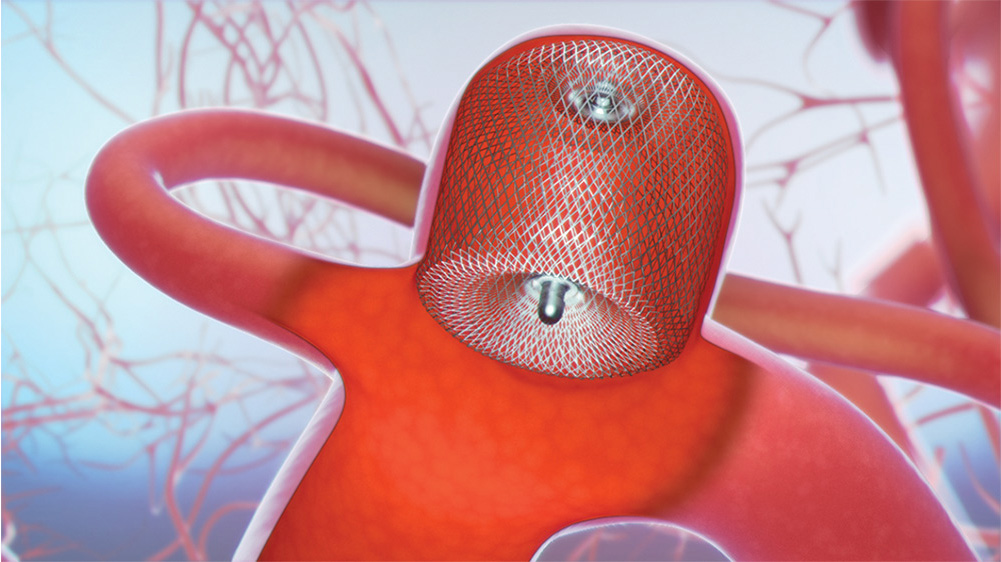BY HOLLY EDMISTON
An aneurysm is an enlargement of arteries caused by a weakening of the artery wall. It can be especially dangerous if located in the brain, where a rupture can cause bleeding that is neurologically devastating. To date, standard treatment for a brain aneurysm includes, among other strategies, medication to control blood pressure, as well as various surgical interventions that essentially seal off the aneurysm as a way to help prevent rupture.

A new device, called WEB, can be an especially effective solution for hard-to-treat brain aneurysms.
Image courtesy of Shutterstock
The Food and Drug Administration has approved use of a new tool to treat brain aneurysms. The device, called WEB, or Woven EndoBridge Aneurysm Embolization System, is a metallic implant that is placed at the site of the aneurysm, where it serves to seal off an unruptured aneurysm and help prevent it from rupturing. Effective for difficult-to-treat aneurysms, WEB has the potential to save lives.
The device system includes the actual implant, a delivery wire and a controller that is used to detach the device from the delivery wire. During the implantation procedure, an endovascular specialist performs an arterial puncture, generally at the groin crease, and then navigates the delivery wire through the arterial system to the aneurysm’s location. There the device is detached from the wire and placed directly into the sac of the aneurysm, where it is expanded, providing a consistent outward force. Once in place, WEB reduces blood flow into the aneurysm and helps promote clotting.
“WEB is the latest innovation to push the envelope to deliver improved outcomes for patients,” says Akash Kansagra, MD, MS, a Washington University interventional neuroradiologist at Barnes-Jewish Hospital.
Aneurysms typically have been treated by sealing them with multiple coils that, compared to WEB, take longer to place and must be built up and then held in place with a stent that acts as a sort of scaffolding, says Kansagra. With WEB, the implantation process is much simpler.
WEB IS THE LATEST INNOVATION TO PUSH THE ENVELOPE TO DELIVER IMPROVED OUTCOMES FOR PATIENTS.
“WEB provides the same level of stability as using coils and a stent, but less manipulation increases the safety of the procedure and means that it can be done in a shorter amount of time,” Kansagra notes. Placement of a stent requires a patient to take blood-thinning medications that are not needed with the WEB.
WEB can be used to treat both ruptured and unruptured aneurysms of varying shapes and sizes. The device itself ranges in size from 3mm (slightly larger than the tip of a pen) to 10mm (the size of a thumbnail).

ONCE IN PLACE, THE DEVICE REDUCES BLOOD FLOW INTO THE ANEURYSM AND HELPS PROMOTE CLOTTING
Image courtesy of Sequent Medical, Inc.
Depending on the location of their aneurysms, some people will not be good candidates for WEB; they will continue to be successfully treated with coils and stents. Other contraindications for WEB include: the presence of bacterial infections that might hinder implantation and hypersensitivity to nickel.
“WEB is a quick and straightforward procedure that can be completed in 15 to 30 minutes,” says Joshua Osbun, MD, a Washington University neurosurgeon at Barnes-Jewish Hospital. Stent-assisted coiling, by comparison, takes about two hours to perform, on average. That means that people implanted with the device are under anesthesia for less time. And in most cases, WEB is covered by insurance.
“The complication rate is exceedingly low for WEB and far lower than other methods used to treat certain aneurysms,” says Osbun. “We have a lot of great solutions for other types of aneurysms, but WEB is a great solution for these most challenging aneurysms.”